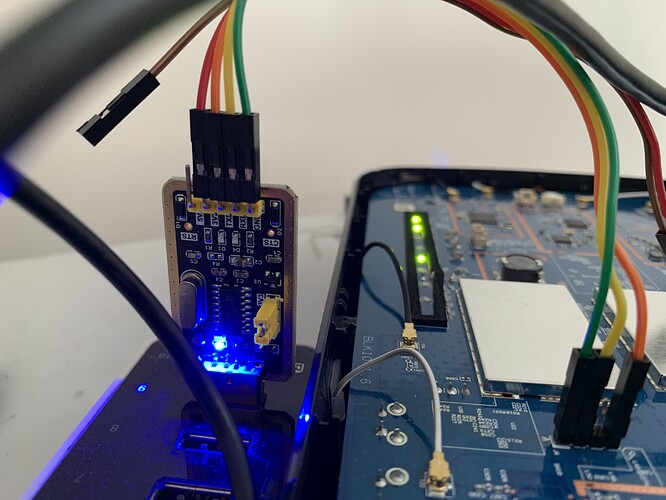I’ve finally connected to my VeraSecure via USB TTY and with the baud rate at 57600, putty it’s showing various activity.
[ 249.812000] led off GPIO_LED_ZIGBEE
[ 249.964000]
[ 249.964000] led off GPIO_LED_LPRF
[ 250.084000]
[ 250.084000] led off GPIO_LED_SERVICE
[ 250.204000]
[ 250.204000] led off GPIO_LED_3G
[ 250.884000] led blink GPIO_LED_WIFI
[ 251.028000] led blink GPIO_LED_BLUETOOTH
[ 257.876000]
[ 257.876000] led off GPIO_LED_ZIGBEE
[ 259.872000]
[ 259.872000] led off GPIO_LED_SERVICE
[ 259.924000]
[ 259.924000] led off GPIO_LED_LPRF
[ 261.128000]
[ 261.128000] led off GPIO_LED_ZIGBEE
[ 261.248000]
[ 261.248000] led off GPIO_LED_LPRF
[ 261.368000]
[ 261.368000] led off GPIO_LED_SERVICE
[ 261.488000]
[ 261.488000] led off GPIO_LED_3G
[ 268.896000]
[ 268.896000] led off GPIO_LED_ZIGBEE
[ 270.896000]
[ 270.896000] led off GPIO_LED_SERVICE
[ 270.960000]
[ 270.960000] led off GPIO_LED_LPRF
[ 272.152000]
[ 272.152000] led off GPIO_LED_ZIGBEE
[ 272.272000]
[ 272.272000] led off GPIO_LED_LPRF
[ 272.392000]
[ 272.392000] led off GPIO_LED_SERVICE
[ 272.508000]
[ 272.508000] led off GPIO_LED_3G
[ 279.952000]
[ 279.952000] led off GPIO_LED_ZIGBEE
[ 281.980000]
[ 281.980000] led off GPIO_LED_SERVICE
[ 282.036000]
[ 282.036000] led off GPIO_LED_LPRF
[ 283.216000]
[ 283.216000] led off GPIO_LED_ZIGBEE
[ 283.336000]
[ 283.336000] led off GPIO_LED_LPRF
[ 283.456000]
Unfortunately the screen keeps on updating with log information to allow me to see anything very easily, plus it will reboot every now and then - but I’ve typed in ifconfig -a and that only lists 4 interfaces (eth0, gre0, gretap0, lo)
eth0 Link encap:Ethernet HWaddr 78:94:B4:F7:85:AC
BROADCAST MULTICAST MTU:1500 Metric:1
RX packets:0 errors:0 dropped:0 overruns:0 frame:0
TX packets:4 errors:0 dropped:0 overruns:0 carrier:0
collisions:0 txqueuelen:1000
RX bytes:0 (0.0 B) TX bytes:1281 (1.2 KiB)
Interrupt:3
gre0 Link encap:UNSPEC HWaddr 00-00-00-00-00-00-D0-33-00-00-00-00-00-00-00-00
NOARP MTU:1476 Metric:1
RX packets:0 errors:0 dropped:0 overruns:0 frame:0
TX packets:0 errors:0 dropped:0 overruns:0 carrier:0
collisions:0 txqueuelen:0
RX bytes:0 (0.0 B) TX bytes:0 (0.0 B)
gretap0 Link encap:Ethernet HWaddr 00:00:00:00:00:00
BROADCAST MULTICAST MTU:1476 Metric:1
RX packets:0 errors:0 dropped:0 overruns:0 frame:0
TX packets:0 errors:0 dropped:0 overruns:0 carrier:0
collisions:0 txqueuelen:1000
RX bytes:0 (0.0 B) TX bytes:0 (0.0 B)
lo Link encap:Local Loopback
LOOPBACK MTU:65536 Metric:1
RX packets:0 errors:0 dropped:0 overruns:0 frame:0
TX packets:0 errors:0 dropped:0 overruns:0 carrier:0
collisions:0 txqueuelen:0
RX bytes:0 (0.0 B) TX bytes:0 (0.0 B)
None of which have an IP address assigned, so I’m guessing my issue is that I can’t get an IP?
If i type reboot I can see it cycle through everything again, but it still does not pick up an IP address, but it does report some interesting things, see extracts below… e.g.
STANDALONE_LOAD_ADDR is 0xa1200000
..
******************************************
Uboot StandAlone Entry
******************************************
Please choose the operation:
2: Load system code then write to Flash via TFTP.
3: Boot system code via Flash (default).
4: Entr boot command line interface.
9: Load Boot Loader code then write to Flash via TFTP. 0
******************************************
Uboot StandAlone Entry
******************************************
Flash Sector Number : 522.
***************************************************
Sercomm Boot Version 3.00.1
***************************************************
Entering Firmware : Everything is OK.
=================================================
Check image validation:
Image1 Header Magic Number --> OK
Image2 Header Magic Number --> Failed
Image1 Header Checksum --> OK
Image1 Data Checksum --> .........................OK
Image1: OK Image2: Broken
..Done!
=================================================
..kernel addr :0xbc140000
flash base: 0xbc000000, kernel addr :0xbc140000, bootloader size: 0x80000, config size 0x80000, fac size : 0x40000
..Erasing NAND Flash...
.Writing to NAND Flash...
done
3: System Boot system code via Flash.
## Booting image at bc140000 ...
Image Name: OpenWrt Linux-3.10.14
Image Type: MIPS Linux Kernel Image (lzma compressed)
Data Size: 1580859 Bytes = 1.5 MB
Load Address: 82001000
Entry Point: 82001000
......................... Verifying Checksum ... OK
Uncompressing Kernel Image ... OK
No initrd
## Transferring control to Linux (at address 82001000) ...
## Giving linux memsize in MB, 256
Starting kernel ...
Also after doing a quick search in the file system,
root@MiOS_5510000:/ ls
1 lib proc sys
bin mios rom tmp
dev mios_constants.sh root usr
etc mnt sbin var
foo overlay storage www
where under storage, I found this…
root@MiOS_5510000:/storage# ls -l
drwxr-xr-x 2 root root 0 Jun 17 2018 cmh-backup
drwxr-xr-x 5 root root 0 Jun 17 2018 cmh-firmware
cmh-backup was empty, but in cmh-firmware, i can see the following
drwxr-xr-x 2 root root 0 May 22 2018 1.7.3062
drwxr-xr-x 2 root root 0 Jun 17 2018 1.7.3535
drwxr-xr-x 2 root root 0 Jan 1 00:00 1.7.3832
-rw-r--r-- 1 root root 156 May 22 2018 error.log
-rw-r--r-- 1 root root 162 Jun 17 2018 latest_firmware.conf
Within the error.log, it seems to only say…
2018-05-22_15:12:38 - ERROR: Failed to copy MiOS Squashfs MD5SUM into jffs2 partition
2018-05-22_15:12:38 - ERROR: Mismatched md5sum of new Firmware Script
Other than the above, I can’t see anything specific to what the cause might be - any ideas ?..
![]()
